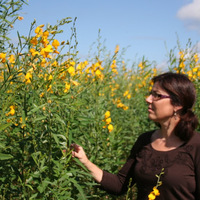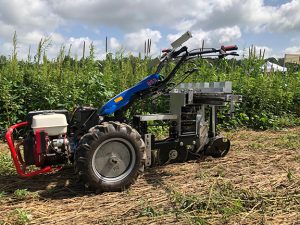
Dr. Danielle Treadwell was the first speaker of the 2020 BMP Summit, which is occurring April 7th through June 23rd. She discussed how cover crops are a tool that can help growers meet BMP goals and how to manage covers in fruit and vegetable systems.
Cover crops are a Florida BMP because they can conserve water, nitrogen, and phosphorus. For example, in citrus production, researchers and farmers have reported the use of cover crops resulted in greater biomass production, reduced evapotranspiration, and increased soil water conservation. Cover crops kept water in the soil for the citrus to use later.
UF/IFAS faculty have been conducting social, economic, and production research to help Florida farmers adopt cover crops successfully. As a part of the National Cover Crop Initiative, the 2017 annual National Cover Crop Survey found that many farmers believed soil health to be a major benefit of cover cropping, and over half believed they would see those benefits within the first year of use. Farmers’ main barriers to cover crop adoption included seed cost and access to mentors and equipment.

Typically, farmers select cover crop species depending on the time of year they will plant the cover and the equipment they have to plant and terminate the cover. In north Florida vegetable systems, cover crops can be planted in the winter between cash crops. In south Florida, cover crops are planted in the summer when it is too hot and too wet to produce a healthy crop. Using a single species or a mix of three species is a good place to start. Your local extension agent can help you determine whether a monoculture or a bi/multi species would work best for your operation. Your management plan should ensure that your cover cropping will not compete with your cash crops and that the cover crops don’t become a weed in the future. Cover crops can be planted by broadcasting or direct seeding. To terminate cover crops, you will need to either mow them, incorporate them into the soil, or roll/crimp the plants.
In general, intercropping is not recommended for beginners because it can create competition for resources. The benefits of cover cropping will be optimized when there is a lot of biomass and when tillage is minimized. The costs incurred by adopting cover cropping depend on the scale of the operation and the management plan. However, cover cropping usually has a positive cost to benefit ratio when used in the long term. For more information on cover cropping, visit: https://edis.ifas.ufl.edu/topic_cover_crops and https://southerncovercrops.org.
Questions about cover crops can be directed to Dr. Danielle Treadwell. Watch the recording of her webinar. View the PDF of her presentation.
Written by Natasha Roberts, CLUE Communications Intern
Cover Crop Questions and Answers
Q: What is AMF Colonization?
A: AMF stands for arbuscular mycorrhizal fungi; they are a fungi that live in the soil naturally and form a symbiotic relationship with roots, which effectively increase the volume of soil occupied by the root because it increases the opportunity for P acquisition.
Q: Part of the adaptability of cover crops by growers is because there are so many different monocultures/mixes to the point that the grower is too confused to make a decision.
A: Well, this is correct, there are a lot of ways. It’s important to see what has been successful in other systems with the same soil type and climate patterns – that will help to rule out a lot of options. For a beginner, it’s best to start with a maximum of 3 species if you’d like to do a mixture. The literature tells us it is also possible to obtain great benefits with a single species. , Some producers use as many as a dozen species, but of course there is a cost to that. Equipment may also limit the number of species that can be planted. Seeds are all different shapes and sizes. Seeds of some tropical legumes may be too large for conventional planters. Planters with only one hopper for seed are not likely to a mixture of large and small seeds at the desired rate, so planters with multiple hoppers are often used to segregate the seed so that each species can be planted simultaneously at different rates.
Q: Can you provide the link to the article of the citrus farmer you mentioned in your talk?
A: The article featured citrus producer Ed James who works with several UF/IFAS faculty including Juanita Popenoe, and was published in the Citrus Industry News magazine: http://citrusindustry.net/2019/11/18/cover-crops-bring-hlb-recovery/
Q: For residential homeowners, can you recommend some cover crops to be used instead of solarization in the summer?
A: Cover crops are not a substitute for soil solarization but can be used to reduce nematodes and weeds. Sunn hemp has documented benefits of reducing nematodes. Scientists do not know the exact mechanism for this, only that the environment reduces the reproduction rate of pathogenic nematodes and thus their population declines over time. Sunn hemp should be terminated after six weeks for homeowners because it gets very woody and difficult to till under. Nearly all cover crops have the potential to reduce weeds if planted at recommended rates and irrigated to establishment. Once established it is not typically necessary to irrigate them at all.
If the goal of solarization is to reduce pathogens, indirectly, there’s evidence that anytime you increase organic matter (e.g. incorporating plant material into soil while simultaneously reducing tillage) you’ll increase the microflora and biological diversity in the soil, which will help to reduce the incidence of soil borne pathogens in some systems. However, most of the evidence about cover crops is in relation to nematode and weed suppression; there is very little evidence of using cover crops for pathogen suppression. There is some inconclusive evidence about the use of Brassia sp. for reducing some organisms, but it is very site specific and it has not been shown to be true in all cases. Using cover crops is not a substitute for solarization.
I have lots of information on cover crops for small-scale producers and gardeners, please contact me and I will be happy to assist!
Q: Could you touch on irrigation with cover crops?
A: It’s important for the cover crops to get established. Seeds and labor are expensive, so it’s important to plant once. Ideally, you’re not spending a lot of money irrigating a cover crop. We also know though, that there is a minimum amount of biomass that’s required to impart benefits. So if you’re in a drought and your choices are to increase biomass production of your cover crop or let the weeds grow, I’d irrigate the cover crop to help to increase its biomass.
Q: Are there good cover crops for high traffic areas where tractors run, like between vegetable crop fields?
A: Yes. Something with a little more carbon, like a cereal grain (winter annual rye or triticale), would be a good option. They have a low amount of nitrogen and therefore they’re going to decompose more slowly. The decomposition rate also has a lot to do with how much biomass a plant has, so if you just have a little bit of biomass a lot of that residue is going to be covered up by soil, which will increase the decomposition rate. If you have 6,000-10,000 lbs of biomass per acre, this will help to keep those row middles clean, facilitate traffic, allow you to get equipment into the field much sooner after rain events. Cover crop biomass on the surface also reduces soil splashing on crops that are close to the ground, thus reducing opportunity for soil borne pathogens to contact foliage and fruit.
Q: Do cover crops attract beneficial insects?
A: Yes, especially pollinators. Buckwheat is a good option for attracting pollinators and beneficials. Many beneficials are quite small. Consider the big-eyed bug for example http://entnemdept.ufl.edu/creatures/beneficial/bigeyed_bugs.htm. Tiny but a mighty predator! Small beneficials often prefer compound flower structures as habitats, as found on buckwheat. The tiny flowers provide a perfect hide-out for predatory beneficial insects. Other cover crops, such as sunflower and sorghum are used as trap crops for stink bugs. This reduces the amount of insecticides needed, as growers just treat the area where the pests are instead of the whole field. Synchronizing cover crop planting ahead of vegetable crops that require pollination is another strategy. Winter annuals that bloom in spring can be used to attract pollinators needed for early spring-planted crops, for example.
Q: When you did the carrot study, were there symptoms of burning at high levels of nitrogen?
A: No, I did not see symptoms of excess nitrogen in the foliage or the roots, nor was there quantitative evidence of excess nitrogen uptake.
Q: With respect to carrots, when you use organic matter did it affect splitting of the roots due to nematodes?
A: I did not notice an increase in nematode damage by nitrogen rate. We did have more nematode damage earlier in the study, but by the end we figured out a good nematode management plan. It took us a while to figure out what inputs we could use; which ones were going to be effective and how to properly handle those materials. Because the experiment was located on certified organic land at NFREC-SV, we used biologically-based pest control measures when all other cultural measures failed. These products are often living organisms that are predators or pathogens of the targeted pest, and so instructions for application are very specific. By the end of the 3rd year we had much less damage from nematodes than our first year, so that was great.
Q: What level of organic matter controlled the nematodes best?
A: That would be a question for Dr. Grabau at UF’s Entomology and Nematology Department.
Q: How can we best help with the 2020 Initiative?
A: Most immediately, encourage your growers to respond to the survey. We have a lot of acreage in Florida that’s in cover crops and it has not accurately been counted. Secondly, if you have a farmer that has an interest in adopting cover crops, I’d be happy to work with you to help them; keep it simple, reduce the risk. There are many faculty working with cover crops, so I am sure that we will be able to assist you.
 0
0
